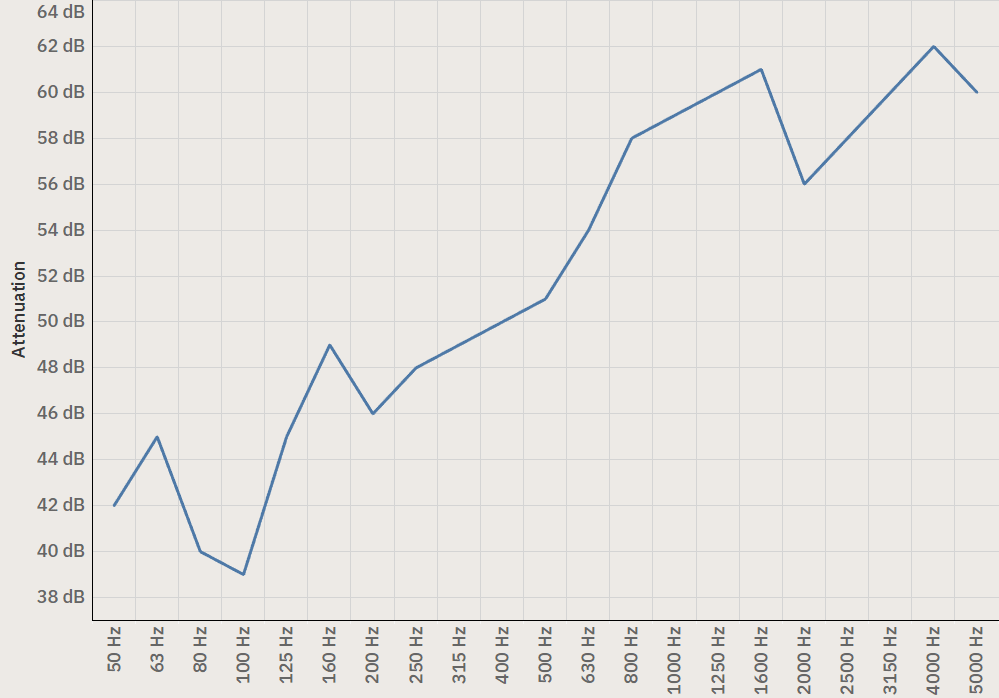STC Ratings – What do they sound like?
Developing an intuition for the sound quality of different walls
# What are STC Ratings?
STC stands for Sound Transmission Class. It is a single number which tells architects and builders how well a certain wall (or ceiling) blocks noise from adjoining spaces.
The factors which contribute to how well a partition blocks sound are complex – mass, stiffness, air space, absorption, construction quality all play a role. The STC rating of a wall assigns a single number to how well it blocks sound.
# Are there problems with the STC metric?
As I see it, there are two problems with the STC metric, which people should be aware of when they decide how to build partitions.
The first is that walls don’t block all frequencies equally. If you look at a graph showing frequency on the X axis, and sound attenuation on the Y axis, you will see the same thing for all wall types:

As you can see, the wall does a great job of blocking high frequencies (60 db attenuation around 1000 Hz) but a comparatively poor job blocking low frequencies (only 40 dB at 80 Hz). For reference, this partition measurement has an STC rating of 56.
The second problem is that people have a poor intuition about the way sound is measured. The amplitude of a sound if measured in dB, which has a logarithmic scale. As a result, people tend to over-estimate the significance of small dB changes (like 2 dB – which is an inaudible difference) and under-estimate the significance of larger dB changes.
To illustrate the latter, refer to the following illustration:
Imagine you are speaking to the man on the right, who is 6 feet away from you. If he was 12 feet away, he would be 6 dB quieter. If he was 24 feet away, he would be 12 dB quieter. Each man in this figure is 6 dB quieter than the next, but as you can see, the distances grow more rapidly than the dB changes!
For reference, here is a chart showing relative distance of a sound compared to dB:
| Distance | dB Difference |
|---|---|
| 6′ | 0 dB |
| 12′ | 6 dB down |
| 24′ | 12 dB down |
| 48′ | 18 dB down |
| 96′ | 24 dB down |
| 192′ | 30 dB down |
| 384′ | 36 dB down |
| 768′ | 42 dB down |
| 1536′ | 48 dB down |
| 3072′ | 54 dB down |
| 1.16 Miles | 60 dB down |
# What do different STC rating sound like?
To account for the fact that partitions tend to block bass poorly, and high frequencies more effectively, the STC calculation uses a frequency adjustment curve, shown below in red:

Simply put, to calculate the STC of a given wall, you measure how much it attenuates different frequencies, and then move this contour line up and down until it overlaps your measurements. The value of this contour line at 500 Hz then becomes your overall STC rating.
However, looking at it another way, the STC contour gives a generalized frequency response for a generic partition. Using this information, we can actually simulate what different STC ratings sound like.
# Sound Samples
The following recordings should give an idea of the relative sound attenuation of different STC ratings. First you will hear the sound as if there was no partition, then you will hear the sound with different wall assemblies, with STC ratings going up by increments of 10.
Notice that the wall changes not only the loudness, but the tonality of the sound, which becomes much more bassy when a wall is introduced.
Loud Conversations at a Party
Dogs Barking
Loud Music
TV News Broadcast
# Why does my wall let in so much noise?
You may notice that the simulated wall of STC 40 is very, very quiet. A typical wood framed house might have exterior walls of at least STC 40, yet it will not block noises as well as these simulations. Why is this?
As I see it, there are two reasons. The first is that windows and doors dramatically decrease the sound blocking properties of a wall. Single-pane windows, often found in older homes, have an STC of 18. To accurately assess the sound-blocking quality of a room, you must take into account all of the wall penetrations, such as windows, doors, ductwork and so on.
The second reason is that construction quality impacts STC rating dramatically, especially in complex wall assemblies specifically designed to block noise. This article (pdf) summarizes how mistakes in the installation of resilient channel can affect the sound transmission rating of the wall.